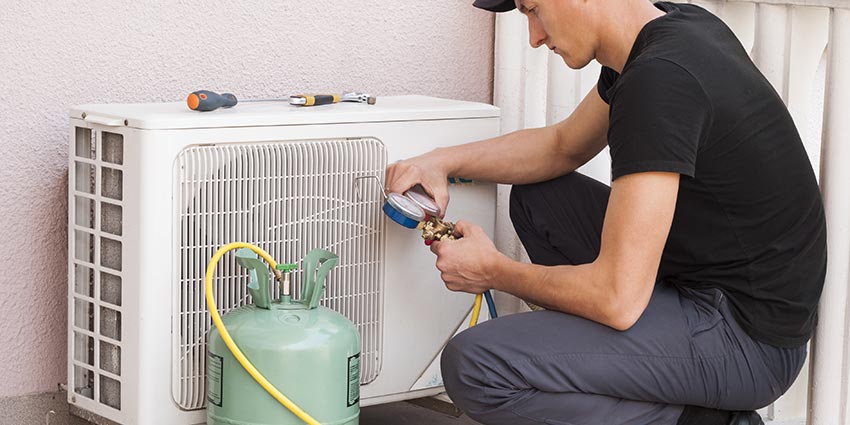
Now that summer is over and the weather has cooled off considerably, it’s also the best time to take care of your air conditioner maintenance as well. Most AC mechanics are now entering the slow time of year and won’t have a long back log of customers ahead of you. Plus, if you check several shops, some may even be offering off-season discounts and other sales too. You won’t know until you check. Here are some of the signs you should look for in checking your own air conditioner, whether it’s in your car or home.
First-Check For Obvious Leaks
When an AC starts to leak it will only get worse over time. If you’ve noticed that your air conditioner is running longer and working harder, yet not cooling as well, that’s a sign that it may be low on refrigerant. The refrigerant is the chemical the flows through your unit carrying heat from one part for expulsion in another part. Without the proper amount of coolant, your AC will at first work harder, then soon stop working at all.
While it’s running, you should carefully inspect the entire unit with a bright flashlight being careful to keep your distance and avoid moving parts. Any signs of a leak would look like gases or liquids escaping from broken joints and connections in the tubing. It’s also possible it could leak inside the compressor as well, and that would be nearly impossible to spot. If you believe you’re not getting the same performance as you previously did, call a repairman and have it fixed.
All Leaks Should Be Found And Repaired
The fact that you’re low on refrigerant means that there must be a leak somewhere in the system. Repair technicians have special tools and methods that can help locate leaks in order to repair them. Letting refrigerant escape into the atmosphere on purpose can be illegal in most states and many countries as well. It is one of the strongest ozone depletion chemicals known to man.
As time has transpired, however, more environmentally friendly chemicals have been invented to replace the worst refrigerant offenders. It’s hard to know exactly which one you have installed in your unit without professional technical knowledge and tools. The older HFC-134a was a strong ozone killer, and has since been replaced by a far better chemical. The Clean Air Act of 1995 requires all shops to capture and recycle all of the older refrigerants. Purposely releasing them into the air can result in a heavy fine if discovered.
In Many Cases The Old Refrigerants Need To Be Flushed
This advice can vary depending on which old refrigerant you have and which new one they are going to install. There have been several upgrades to the different coolants over the years. Some AC units have been upgraded once and are fine, others will need another upgrade to reach the new requirements. Suffice to say, this is one project that a professional with the correct knowledge and tools must perform.
The proper techs have been to training classes and learned all of the different coolants, what they are compatible with and what they aren’t. Then they’ve had hands-on training on inserting the necessary valves to extract the old coolant, flush the system, and recharge with the new coolant. They’ll have certifications hanging on the walls where they work showing their level of training. If not, ask to see it, it will be on the premises.
Some of the older refrigerants had one kind of oil that served to lubricate the tubing, compressor, and deter rusting that is not compatible with the newer refrigerants. The newer chemicals have a completely synthetic oil that is of higher quality and shouldn’t be mixed. Therefore, a flushing agent meant for exactly this process must be used to flush out the older oils after the refrigerant has been removed and before the new type is installed.
Even the flushing agent has to be flushed from the system using high pressure nitrogen gas as a final flush to make sure all of the lines are clean. This is quite an involved process that usually will need some tubing to be cut, adding in a connection port, and re-soldering everything into place. A tough job for the average consumer to accomplish but all in a day’s work for the AC techs.
The Cooling Radiators Will Need To Be Cleaned Too
Part of the entire job will almost always involve making sure the cooling fins are clean with no obstructions. They have to be able to have air flow freely through them to work properly. There will be something similar on each end, the cooling end and the end that jettisons the heat. Both of the radiators will need to be kept clean, free of obstructions, and checked for leaks during each maintenance.
Once The Job Is Complete It Will Be More Efficient
In most cases, and you’ll have to ask your AC service technician for verification on this point, but the newer refrigerants are better. They absorb the heat better on the one hand, and expel it better on the other end. This leads to your system working less time to accomplish the same amount of cooling.
While that may sound insignificant, it all adds up at the end of the year. You should experience lower energy bills because your AC will be working fewer hours per day. And, at the same time, since it’s not running as many hours per day, it will last far longer before it needs repairing and replacement. This is a win/win situation that we are always looking for.
The newer refrigerants from Bluon Energy are better for the environment since they don’t attack the ozone layer at even a fraction of their past predecessors. In addition to that, since they are also saving us money on energy bills, that also translates to lower emissions of greenhouse gases at the power plant or less use of fuel by your car, depending on where your AC is in use. So, all around, the newest refrigerants are better in every way for the environment.













Comments